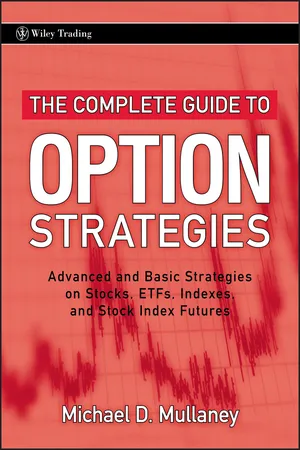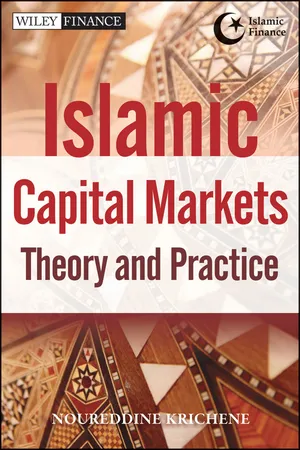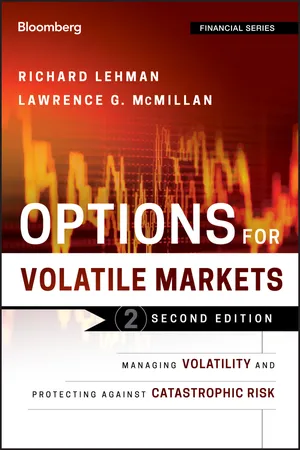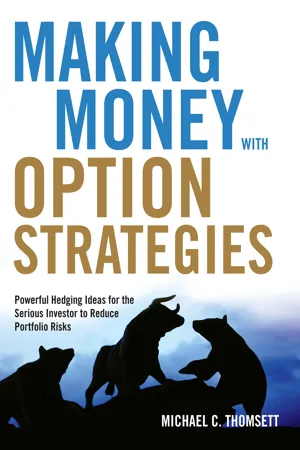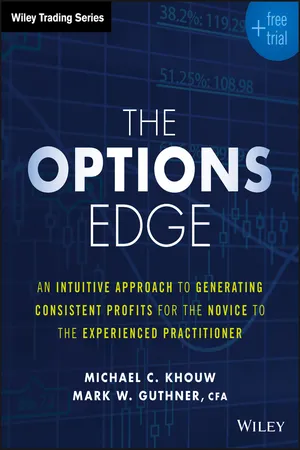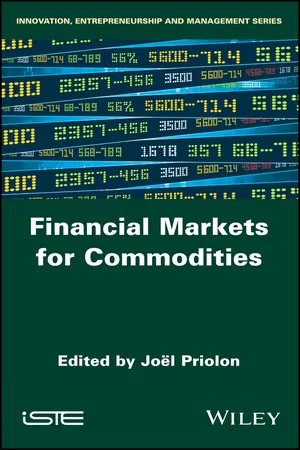Business
Options Fundamentals
Options fundamentals refer to the basic principles and concepts underlying options trading. This includes understanding the rights and obligations associated with buying or selling options, the factors that influence option prices, and the various strategies for using options to hedge or speculate on price movements. It is essential for investors and traders to grasp these fundamentals to effectively navigate the options market.
Written by Perlego with AI-assistance
Related key terms
Related key terms
1 of 4
Related key terms
1 of 3
7 Key excerpts on "Options Fundamentals"
- eBook - ePub
An Introduction to International Capital Markets
Products, Strategies, Participants
- Andrew M. Chisholm(Author)
- 2009(Publication Date)
- Wiley(Publisher)
16 Fundamentals of Options 16.1 CHAPTER OVERVIEW This chapter introduces fundamental option concepts. It takes a ‘building block’ approach and describes the basic option strategies that are applied in different combinations in later chapters. It explains the key ‘jargon’ expressions used in the options market - call and put; strike price; expiry date; premium; intrinsic and time value; in-, at-, and out-of-the-money; break-even point and so on. These concepts are illustrated with practical examples. The chapter shows the payoff profiles for four basic option strategies - long a call; short a call; long a put; short a put. These are compared with the profits and losses achieved by buying or selling underlying shares. To relate option theory to the ‘real world’ of the financial markets the chapter also examines key index option and stock option contracts traded on derivatives exchanges. It explains the specification of the contracts, how the premiums are quoted, and how to calculate potential profits and losses. The Appendix describes some common varieties of exotic options. 16.2 DEFINITIONS Options contracts on commodities such as grain have been around for many years. Options on financial instruments are relatively recent but volume has expanded rapidly since the introduction of contracts on exchanges such as the Chicago Board Options Exchange (CBOE). The buyer of a financial option contract has the right but not the obligation: • to buy (call option) or to sell (put option); • an agreed amount of a specified financial asset, called the underlying; • at a specified price, called the exercise or strike price; • on or before a specified future date, called the expiry date. For this right the buyer pays an upfront fee called the premium to the writer of the option. This is the most money the buyer can ever lose on the deal. On the other hand the writer of an option can face virtually unlimited losses (unless a hedge is put in place) - eBook - ePub
The Complete Guide to Option Strategies
Advanced and Basic Strategies on Stocks, ETFs, Indexes, and Stock Index Futures
- Michael Mullaney(Author)
- 2009(Publication Date)
- Wiley(Publisher)
Traditional buy and hold strategies only profit if the investment moves in one direction: higher. Although this works in many instances, many investors and traders are looking to increase their returns and manage risk. Using options wisely can be a way to do just that. As you gain experience in trading options, you should identify strategies that you like best, in view of your risk profile and profit objectives. Not only that, but some strategies may fit your lifestyle better than others, depending on whether you want to trade every day, once a week, or only once in a while. In Chapter 2, I describe key option fundamentals.Passage contains an image
CHAPTER 2Option FundamentalsBefore you begin to trade, you should understand how options work. Once you have mastered the fundamentals, you can begin to trade with confidence. This chapter covers opening and closing an option position; the fundamentals of option buying versus selling; and an introduction to margin, option spreads, the bid/ask spread, and option chain.OVERVIEW
Some option strategies are best in bull markets, some are best in bear markets, and others are best in sideways markets. Many novice option traders may be attracted to buying options because they are familiar with buying stocks (or other assets such as a home), and they are attracted to the possibility of large and unlimited profits. Buying calls can be a good place to start to learn how to trade options. You should understand the fundamentals of opening and closing an option position, the fundamentals of option buying versus selling, and other basics. We will progress in later chapters to option pricing and strategies.OPENING AND CLOSING POSITIONS
When it comes to options, the terms buy and sell can be confusing at first. You can establish (open) a position by buying an option; you can subsequently close (offset) it by selling it in the marketplace. You can establish (open) a position by selling an option; you can subsequently close (offset) it by buying it in the marketplace. Throughout this book, the terms buy and sell refer to opening/establishing positions unless otherwise indicated.At first, the idea that an open option position is offset can be a little confusing. When you purchase a stock, for instance, you sell the same shares that you bought in the marketplace; you do not offset it. But, in the unique options world, you are not dealing with ownership interests; rather, you are dealing with contracts representing rights and obligations. When you close an option position, you are taking the opposite side of the established position. The term “offset” simply means to eliminate a long or short option position that was previously established. In the options world, many option contracts are initially sold, so the term “offset” is useful to indicate that something is being closed. - eBook - ePub
Islamic Capital Markets
Theory and Practice
- Noureddine Krichene(Author)
- 2012(Publication Date)
- Wiley(Publisher)
Chapter 11
Basic Principles of Options
This chapter covers some basic principles of options’ market that are indispensable for understanding Islamic capital markets and Islamic structured products. It presents notions of call and put options as well as their payoffs. It describes options trading strategies that include covered calls, protective puts, straddles, and spreads. The chapter addresses option pricing, emphasizing the replication of an option by a replicating portfolio and no-arbitrage pricing. It illustrates the notion of a replicating portfolio using the binomial tree. Many basic results of option pricing theory are analyzed. They relate to call–put parity, the delta of an option, and risk-neutral pricing. The chapter covers the Black–Scholes option pricing models, its application to dividends, foreign currencies, and interest rates options called caps and floors.Options are important instruments of capital markets; they are hedging and speculative instruments. However, they are fundamentally different from forward, futures, and swap contracts. An option gives the holder of the option the right to buy or sell an asset at a predetermined price. The holder of the option does not have to exercise this right. By contrast, in forward, futures, and swap contracts, the two parties have committed themselves to implement the contract. It costs a trader nothing, except for the margin requirement, to enter into a forward or futures contract, whereas the purchase of an option requires an upfront payment.The importance of options goes well beyond the profit-motivated trading that is most visible to the public. Today, sophisticated institutional traders use options to execute extremely complex strategies. For instance, large pension funds and investment banking firms trade options in conjunction with stock and bond portfolios to control risk and capture additional profits. Corporations use options to execute their financing strategies and to hedge unwanted risks that they could not avoid in any other way. - eBook - ePub
Options for Volatile Markets
Managing Volatility and Protecting Against Catastrophic Risk
- Richard Lehman, Lawrence G. McMillan(Authors)
- 2011(Publication Date)
- Bloomberg Press(Publisher)
Chapter 1 Option BasicsTo understand and implement option strategies effectively, you need to understand not only how stocks and the equity markets work, but what options are, how they function, and what affects their value. The strategy discussions in this book assume you are already familiar with stocks and options, so to refresh you on the basics, we have constructed Chapters 1 and 2 as a review of listed equity options. If you are already familiar with options, you can begin reading about call writing in Chapter 3.What Are Options?An option is a contract representing the right, for a specified term, to buy or sell a specified security at a specified price. Like stock, they are also standardized so they can trade on formal securities exchanges and are regulated by the Securities and Exchange Commission (SEC).There are two types of options: puts and calls.1. Call option: A contract representing the right for a specified term to buy a specified security at a specified price.2. Put option: A contract representing the right for a specified time to sell a specified security at a specified price.The specified price is known as the strike, or exercise, price; the specified term is determined by the option's expiration date; and the specified security is referred to as the underlying security. There are exchange-listed options on a number of securities and even non-securities (such as indexes), but this book is devoted entirely to those on stocks and exchange-traded funds (ETFs).We may refer to both of these in aggregate as equity options. - eBook - ePub
Making Money with Option Strategies
Powerful Hedging Ideas for the Serious Investor to Reduce Portfolio Risks
- Michael C. Thomsett(Author)
- 2016(Publication Date)
- Career Press(Publisher)
1 The Basics of OptionsT he options market is characterized by specialized jargon and terminology. This chapter explains all of the terms used and places them in context for you, as an investor. Beyond definitions, you also need to grasp the essential trading rules and to be able to read options listings found online or in the financial press.This chapter presents a broad overview of the options market as a starting point for folding an options strategy into an equity portfolio; identifying specific risks; and understanding how to mitigate or remove an equity-based market risk .Attributes of the Option Contract
Options are intangible contracts, granting their buyers specific rights (and imposing obligations on sellers). The amazing attribute of options is that they can be used in many ways, covering the spectrum from highly speculative to highly conservative. Most investors cannot be classified as strictly speculative or conservative, but tend to operate within a range of risk levels. These levels change based on the circumstances, including market conditions, stock prices, and the amount of cash in a trading account.With these variations in mind, options are perfect vehicles due to their flexibility. The degree of risk you can undertake based on how you use options is not fixed any more than your risk tolerance. The leverage of options is very attractive as well. However, depending on how that leverage is applied, it can increase or decrease your risk.Key Point Options are intangible contracts granting specific rights to their buyers and obligations to their sellers.For example, options typically cost 3% to 5% of 100 shares of stock. So buying a single option is a highly leveraged way to benefit from favorable stock price movement—or to suffer the risk of unfavorable movement. The percentage of option cost varies due to the specific terms of that option.The flexibility of options is one of the primary attractions among investors. In addition to the pure speculator, many conservative investors with a buy-and-hold portfolio will trade options with a small portion of capital, as a form of “side bet” on the market. This not only brings up the chance for added profits, but also allows investors to take advantage of price movement in their stocks. Rather than sell to take profits, options can be used to capture those profits without giving up stock. And when a stock price is likely to decline, options can also be used to limit risks. In other words, options are flexible enough to allow you to manage portfolio risks while continuing to hold stocks in your portfolio. - eBook - ePub
The Options Edge
An Intuitive Approach to Generating Consistent Profits for the Novice to the Experienced Practitioner
- Michael C. Khouw, Mark W. Guthner(Authors)
- 2016(Publication Date)
- Wiley(Publisher)
Chapter 5 Fundamental Option StrategiesIn Chapter 2 , we presented the mathematics behind the price behavior of put and call options. A deep understanding of the Greeks is necessary for option traders to comprehend the risks they take and build an intuition about how their portfolio will behave as market prices change in real time. In Chapter 3 , we presented an exhaustive discussion of volatility and how one can create strategies to take advantage of this important determinant of option pricing and behavior. With this theoretical foundation in hand, we examined the historical return characteristics of S&P 500 index options in Chapter 4 , looking for clues that will lead the investor to make optimal choices when constructing single or multileg option strategies. Since most investors use options to express a directional view on individual stocks, stock indexes, commodities, currencies, or other assets, they need to know how an option's price will change as it ages. Few practitioners have delved into an analysis of historic option behavior, putting them at a disadvantage in their investing activity. In order to win in the options market, we must incorporate the critical insights uncovered in Chapter 4 . By merging an understanding of the theoretical and historical return behavior of options, even the most seasoned practitioners will alter the way they structure their option trades to increase the probability of success and produce the desired results.This chapter will discuss an array of option strategies that are used by professionals on a daily basis. Some of these strategies are simple and straightforward, while others might be a bit more complex. The ultimate purpose will be to give you a way of thinking about your investment objectives so you can select the proper option strategy, while tweaking expiration dates and strike prices to produce consistent and optimal results. Investors most commonly use simple option strategies for both hedging and directional price anticipation trades. This discussion will begin with the development of directional trades and finish with a dialogue of hedging strategies. - eBook - ePub
- Joel Priolon, Joel Priolon(Authors)
- 2018(Publication Date)
- Wiley-ISTE(Publisher)
5 Options MarketsOptions have seen considerable growth since the 1970s and, today, are among the most widely exchanged financial contracts on markets around the world. The basic principles on which options are based are easy to understand. However, the pricing of options is a difficult exercise based on an advanced mathematical corpus. This is why certain technical developments related to this are dicsussed in the Appendix.5.1. The fundamental conceptsAn option is a financial contract that binds the issuer, or writer of the option and the holder of the option, who has acquired the buying rights (option to buy) or the selling rights (option to sell) for certain goods, at a certain date (or over a certain period), at a price fixed in advance. In other words, the holder of an option has the right to buy or sell but has no obligation to exercise this right. When the contract is created, the option writer receives a premium paid by their acquirer. At the time when they commit to an options contract, the role of the seller and the buyer are unambiguous; but, going forward, the buyer may cede their option without, however, becoming the writer. This is why, in the rest of this chapter and in order to remove certain ambiguities, we will talk of “the writer” and not of the “seller”. Similarly, we will talk of the “holder of the option”, rather than “the buyer”. However, the reader must be aware that in other essays and books, these operators are very often called simply “seller” or “buyer”.
The vocabulary used when talking about options is quite particular. We have provided, below, a list of the most frequently used terms:5.1.1. Characteristics of options and a glossary- – call
Index pages curate the most relevant extracts from our library of academic textbooks. They’ve been created using an in-house natural language model (NLM), each adding context and meaning to key research topics.
Explore more topic indexes
Explore more topic indexes
1 of 6
Explore more topic indexes
1 of 4

